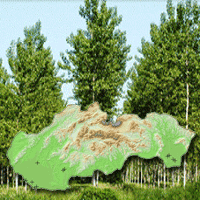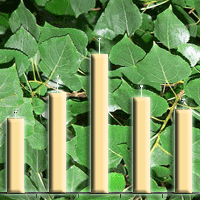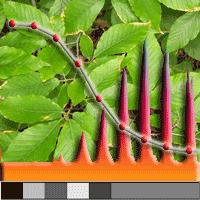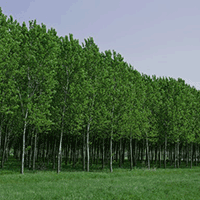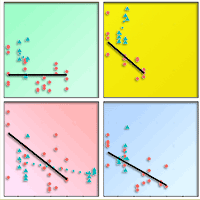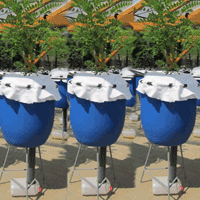It is a challenge to produce woody crops on marginal land. The goal of this study was to examine growth responses and nitrogen use efficiency of different poplar species on shallow soil. Typical biomass poplar clones of Max1 (P. nigra × P. maximowiczii) and H275 (P. trichocarpa × P. maximowiczii) were planted on a marginal site where a gradient in soil depth was present. The growth, biomass production, and nitrogen uptake rate as well as nitrogen use efficiency of Max1 and H275 were determined for three consecutive years. Both poplar clones showed decreased growth and biomass production in the shallow soil. Max1 showed better adaptation to shallow soil with higher survival rate and more biomass production than H275. Max1 had lower nitrogen use efficiency on shallow soil than H275. The results suggest that higher nitrogen uptake of poplar species might be an important adaptation to maintain productivity under unfavorable soil conditions.
Keywords
, , ,
Citation
Euring D, Ayegbeni S, Jansen M, Tu J, Gomes Da Silva C, Polle A (2016). Growth performance and nitrogen use efficiency of two Populus hybrid clones (P. nigra × P. maximowiczii and P. trichocarpa × P. maximowiczii) in relation to soil depth in a young plantation. iForest 9: 847-854. - doi: 10.3832/ifor2016-009
Academic Editor
Gianfranco Minotta
Paper history
Received: Feb 18, 2016
Accepted: Jul 19, 2016
First online: Sep 22, 2016
Publication Date: Dec 14, 2016
Publication Time: 2.17 months
© SISEF - The Italian Society of Silviculture and Forest Ecology 2016
Open Access
This article is distributed under the terms of the Creative Commons Attribution-Non Commercial 4.0 International (https://creativecommons.org/licenses/by-nc/4.0/), which permits unrestricted use, distribution, and reproduction in any medium, provided you give appropriate credit to the original author(s) and the source, provide a link to the Creative Commons license, and indicate if changes were made.

Breakdown by View Type
(Waiting for server response...)
Article Usage
Total Article Views: 51455
(from publication date up to now)
Breakdown by View Type
HTML Page Views: 43048
Abstract Page Views: 3088
PDF Downloads: 4059
Citation/Reference Downloads: 54
XML Downloads: 1206
Web Metrics
Days since publication: 3360
Overall contacts: 51455
Avg. contacts per week: 107.20
Article Citations
Article citations are based on data periodically collected from the Clarivate Web of Science web site
(last update: Mar 2025)
Total number of cites (since 2016): 11
Average cites per year: 1.10
Publication Metrics
by Dimensions ©
Articles citing this article
List of the papers citing this article based on CrossRef Cited-by.
(1)
Ad-Hoc-Arbeitsgruppe (2005)Bodenkundliche Kartieranleitung [Soil Mapping] (5th edn). Bundesanstalt für Geowissenschaften und Rohstoffe, Stuttgart, Germany, pp. 127. [in German]
Gscholar
(2)
Bai H, Euring D, Volmer K, Janz D, Polle A (2013)The nitrate transporter (NRT) gene family in poplar. PloS ONE 8: e72126.
CrossRef |
Gscholar
(3)
Bogeat-Triboulot M, Brosché M, Renaut J, Jouve L, Le Thiec D, Fayyaz P, Vinocur B, Witters E, Laukens K, Teichmann T (2007)Gradual soil water depletion results in reversible changes of gene expression, protein profiles, ecophysiology, and growth performance in
Populus euphratica, a poplar growing in arid regions. Plant physiology 143: 876-892.
CrossRef |
Gscholar
(4)
Bredemeier M, Busch G, Hartmann L, Jansen M, Richter F, Lamersdorf N (2015)Fast growing plantations for wood production-integration of ecological effects and economic perspectives. Frontiers in Bioengineering and Biotechnology 3: 1-14.
CrossRef |
Gscholar
(5)
Broeckx LS, Fichot R, Verlinden MS, Ceulemans R (2014)Seasonal variations in photosynthesis, intrinsic water-use efficiency and stable isotope composition of poplar leaves in a short-rotation plantation. Tree Physiology 34 (7): 701-715.
CrossRef |
Gscholar
(6)
Bungart R, Hüttl RF (2004)Growth dynamics and biomass accumulation of 8-year-old hybrid poplar clones in a short-rotation plantation on a clayey-sandy mining substrate with respect to plant nutrition and water budget. European Journal of Forest Research 123: 105-115.
CrossRef |
Gscholar
(7)
Burgess J, Szlavecz K, Rajakaruna N, Swan C (2015)Ecotypic differentiation of mid-Atlantic
Quercus species in response to ultramafic soils. Australian Journal of Botany 63 (4): 308.
CrossRef |
Gscholar
(8)
Castro-Rodríguez V, García-Gutiérrez A, Canales J, Cañas RA, Kirby EG, Avila C, Cánovas FM (2015)Poplar trees for phytoremediation of high levels of nitrate and applications in bioenergy. Plant Biotechnology Journal 14 (1): 299-312.
CrossRef |
Gscholar
(9)
Crow P (2005)The influence of soils and species on tree root depth. Information Note 78, Forestry Commission, Edinburgh, UK, pp. 4.
Gscholar
(10)
Ehlting B, Dluzniewska P, Dietrich H, Selle A, Teuber M, Hänsch R, Nehls U, Polle A, Schnitzler J, Rennenberg H, Gessler A (2007)Interaction of nitrogen nutrition and salinity in Grey poplar (
Populus tremula ×
alba). Plant, Cell and Environment 30: 796-811.
CrossRef |
Gscholar
(11)
Euring D, Löfke C, Teichmann T, Polle A (2012)Nitrogen fertilization has differential effects on N allocation and lignin in two
Populus species with contrasting ecology. Trees 26 (6): 1933-1942.
CrossRef |
Gscholar
(12)
Euring D, Bai H, Janz D, Polle A (2014)Nitrogen-driven stem elongation in poplar is linked with wood modification and gene clusters for stress, photosynthesis and cell wall formation. BMC Plant Biology 14: 391.
CrossRef |
Gscholar
(13)
Field C, Merino J, Mooney HA (1983)Compromises between water-use efficiency and nitrogen-use efficiency in five species of California evergreens. Oecologia 60 (3): 384-389.
CrossRef |
Gscholar
(14)
Gan H, Jiao Y, Jia J, Wang X, Li H, Shi W, Peng C, Polle A, Luo Z (2015)Phosphorus and nitrogen physiology of two contrasting poplar genotypes when exposed to phosphorus and/or nitrogen starvation. Tree Physiology 36 (1): 22-38.
CrossRef |
Gscholar
(15)
Hennig A, Kleinschmit JRG, Schoneberg S, Löffler S, Janssen A, Polle A (2015)Water consumption and biomass production of protoplast fusion lines of poplar hybrids under drought stress. Frontiers in Plant Science 6: 242.
CrossRef |
Gscholar
(16)
Isebrands JG, Richardson J (2014)Poplars and willows: trees for society and the environment. CABI, Canada, pp. 311-656.
Online |
Gscholar
(17)
Jiang D, Hao M, Fu J, Zhuang D, Huang Y (2014)Spatial-temporal variation of marginal land suitable for energy plants from 1990 to 2010 in China. Scientific Reports 4: 5816.
CrossRef |
Gscholar
(18)
Kauter D, Lewandowski I, Claupein W (2003)Quantity and quality of harvestable biomass from
Populus short rotation coppice for solid fuel use’a review of the physiological basis and management influences. Biomass and Bioenergy 24 (6): 411-427.
CrossRef |
Gscholar
(19)
Khamzina A, Lamers JP, Worbes M, Botman E, Vlek PL (2006)Assessing the potential of trees for afforestation of degraded landscapes in the Aral Sea Basin of Uzbekistan. Agroforestry Systems 66 (2): 129-141.
CrossRef |
Gscholar
(20)
Lajtha K, Whitford W (1989)The effect of water and nitrogen amendments on photosynthesis, leaf demography, and resource-use efficiency in
Larrea tridentata, a desert evergreen shrub. Oecologia 80 (3): 341-348.
CrossRef |
Gscholar
(21)
Lee K, Jose S (2003)Soil respiration, fine root production, and microbial biomass in cottonwood and loblolly pine plantations along a nitrogen fertilization gradient. Forest Ecology and Management 185 (3): 263-273.
CrossRef |
Gscholar
(22)
Li H, Li M, Luo J, Cao X, Qu L, Gai Y, Jiang X, Liu T, Bai H, Janz D (2012)N-fertilization has different effects on the growth, carbon and nitrogen physiology, and wood properties of slow-and fast-growing
Populus species. Journal of Experimental Botany 63 (17): 6173-6185.
CrossRef |
Gscholar
(23)
Liesebach M, Von Wuehlisch G, Muhs H (1999)Aspen for short-rotation coppice plantations on agricultural sites in Germany: effects of spacing and rotation time on growth and biomass production of aspen progenies. Forest Ecology and Management 121: 25-39.
CrossRef |
Gscholar
(24)
Liu F, Stützel H (2004)Biomass partitioning, specific leaf area, and water use efficiency of vegetable amaranth (
Amaranthus spp.) in response to drought stress. Scientia horticulturae 102: 15-27.
CrossRef |
Gscholar
(25)
Luo J, Li H, Liu T, Polle A, Peng C, Luo Z (2013)Nitrogen metabolism of two contrasting poplar species during acclimation to limiting nitrogen availability. Journal of Experimental Botany 64 (14): 4207-4224.
CrossRef |
Gscholar
(26)
Luo J, Zhou J, Li H, Shi W, Polle A, Lu M, Sun X, Luo Z (2015)Global poplar root and leaf transcriptomes reveal links between growth and stress responses under nitrogen starvation and excess. Tree Physiology 35: 1283-1302.
CrossRef |
Gscholar
(27)
Lynch J (1995)Root architecture and plant productivity. Plant Physiology 109: 7-13.
Online |
Gscholar
(28)
McLaughlin RA, Hansen EA, Pope PE (1987)Biomass and nitrogen dynamics in an irrigated hybrid poplar plantation. Forest Ecology and Management 18: 169-188.
CrossRef |
Gscholar
(29)
Millard P, Grelet G (2010)Nitrogen storage and remobilization by trees: ecophysiological relevance in a changing world. Tree Physiology 30: 1083-1095.
CrossRef |
Gscholar
(30)
Miller BD, Hawkins BJ (2003)Nitrogen uptake and utilization by slow-and fast-growing families of interior spruce under contrasting fertility regimes. Canadian Journal of Forest Research 33: 959-966.
CrossRef |
Gscholar
(31)
Molina-Rueda JJ, Kirby EG (2015)Transgenic poplar expressing the pine GS1a show alterations in nitrogen homeostasis during drought. Plant Physiology and Biochemistry 94: 181-190.
CrossRef |
Gscholar
(32)
Nielsen UB, Madsen P, Hansen JK, Nord-Larsen T, Nielsen AT (2014)Production potential of 36 poplar clones grown at medium length rotation in Denmark. Biomass and Bioenergy 64: 99-109.
CrossRef |
Gscholar
(33)
Patterson TB, Guy RD, Dang QL (1997)Whole-plant nitrogen- and water-relations traits, and their associated trade-offs, in adjacent muskeg and upland boreal spruce species. Oecologia 110 (2): 160-168.
CrossRef |
Gscholar
(34)
Pleguezuelo C, Zuazo V, Bielders C, Bocanegra J, PereaTorres F, Martínez J (2015)Bioenergy farming using woody crops. A review. Agronomy for Sustainable Development 35 (1): 95-119.
CrossRef |
Gscholar
(35)
Polle A, Janz D, Teichmann T, Lipka V (2013)Poplar genetic engineering: promoting desirable wood characteristics and pest resistance. Applied Microbiology and Biotechnology 97 (13): 5669-5679.
CrossRef |
Gscholar
(36)
Pregitzer KS, Dickmann DI, Hendrick R, Nguyen PV (1990)Whole-tree carbon and nitrogen partitioning in young hybrid poplars. Tree Physiology 7: 79-93.
CrossRef |
Gscholar
(37)
Reich PB (2002)Root-shoot relations: optimality in acclimation and adaptation or the “Emperors’ New Clothes”. In: “Plant Roots: the Hidden Half” (Waisel Y, Eshel A, Kafkaki U eds). Marcel Dekker, New York, USA, pp. 205-220.
Online |
Gscholar
(38)
Rennenberg H, Wildhagen H, Ehlting B (2010)Nitrogen nutrition of poplar trees. Plant Biology 12 (2): 275-291.
CrossRef |
Gscholar
(39)
Sadras VO, Rodriguez D (2010)Modelling the nitrogen-driven trade-off between nitrogen utilisation efficiency and water use efficiency of wheat in eastern Australia. Field Crops Research 118: 297-305.
CrossRef |
Gscholar
(40)
Schildbach M, Wolf H, Hartmann K (2012)Untersuchungen zur abiotischen Resistenz schnellwachsender Baumarten [Analysis of abiotic resistance of fast growing trees]. In: “Züchtung und Ertragsleistung schnellwachsender Baumarten im Kurzumtrieb” [Breeding of fast-growing tree species]. Nordwestdeutsche Forstliche Versuchsanstalt, Hann. Münden, Germany, vol. 8, pp. 237-257. [in German]
Gscholar
(41)
Shortall OK (2013)“Marginal land” for energy crops: exploring definitions and embedded assumptions. Energy Policy 62: 19-27.
CrossRef |
Gscholar
(42)
Street NR, Skogström O, Sjödin A, Tucker J, Rodríguez-Acosta M, Nilsson P, Jansson S, Taylor G (2006)The genetics and genomics of the drought response in
Populus. The Plant Journal 48 (3): 321-341.
CrossRef |
Gscholar
(43)
Thieret JW (1982)Trees and shrubs hardy in the British Isles. Economic Botany 36 (3): 273.
Gscholar
(44)
Tschaplinski TJ, Tuskan GA, Gebre GM, Todd DE (1998)Drought resistance of two hybrid
Populus clones grown in a large-scale plantation. Tree Physiology 18: 653-658.
CrossRef |
Gscholar
(45)
Viger M, Taylor G (2012)Adaptive mechanisms and genomic plasticity in drought tolerance identified in a European population of Black Poplar (
Populus nigra L.). In: Proceedings of the Conference “Plant and Animal Genome XX Conference2. San Diego (CA, USA) 14-18 Jan 2012, abstract book, paper no. 2689.
Online |
Gscholar
(46)
Vitousek PM, Gerrish G, Turner DR, Walker LR, Mueller-Dombois D (1995)Litterfall and nutrient cycling in four Hawaiian montane rainforests. Journal of Tropical Ecology 11: 189-203.
CrossRef |
Gscholar
(47)
Wetterstation Goettingen (2014)Archiv 2011-2014. Goettingen, Germany, web site.
Online |
Gscholar
(48)
Zalesny Jr RS, Cunningham MW, Hall RB, Mirck J, Rockwood DL, Stanturf JA, Volk TA (2011)Woody biomass from short rotation energy crops. Sustainable production of fuels, chemicals, and fibers from forest biomass 1067: 27-63.
CrossRef |
Gscholar


